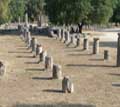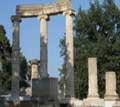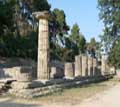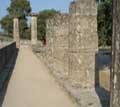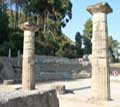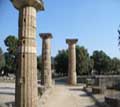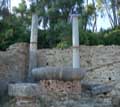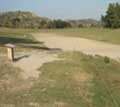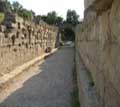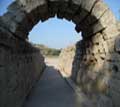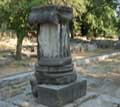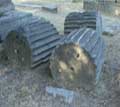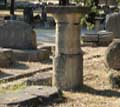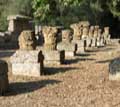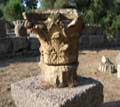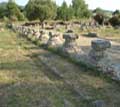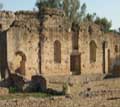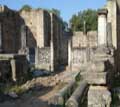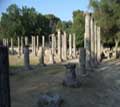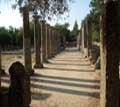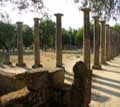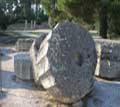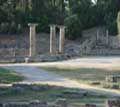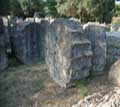
ADMINISTRATIVE AREA OF ELIS
The Sanctuary of Olympia is spread out at the foot of the hill of Kronio, between the Alfeios and the tributary of the Kladeos. The origins of the cult at Olympia are lost in the centuries. Evidence that we have in the area for the practice of worship in the area comes from the Mycenaean era, when Pelops and Hippodamia were worshiped, while even earlier Saturn, Rhea, Eileithyia, Themis and the Ideal Heracles must have been worshiped here. At the end of the 4th c. BC, the Sanctuary acquires its definitive form, which undergoes interventions and modifications during the Hellenistic and Roman years.Gymnasium: Rectangular building with an inner courtyard and arcades on the four sides. It was built in the 2nd century BC and due to the size of the building, it was here that athletes trained in events that required space, such as javelin, road and discus.
Palestra: In the 3rd c. BC is built for the training needs of athletes in wrestling, jumping and boxing. A square building with an inner courtyard, it had rooms for changing rooms, baths, an oil mill, a powder room, etc.
Theikoleon: North of the workshop is built the Theikoleon, which was used for the residence of the theikoles, priests of Olympia. In the Roman years, it received the addition of a courtyard and a peristyle.
Iroon: Circular building, west of Theikoleon, with an altar dedicated to an unknown hero.
Pheidias' workshop: It is located west of the temple and was built specifically for the needs of the construction of the statue. It is a rectangular oblong building with two internal colonnades. Tools and clay molds are preserved from its site. With the establishment of a Christian settlement in Olympia, the workshop was transformed into a Christian basilica, in the 5th century AD.
Baths - Thermes: In the 5th century BC are built near Cladeos Loutras, which in 100 BC. are supplied with fuel. The Western Thermal Baths are being built near them. Their floors are decorated with wonderful mosaics.
Leonidaio: The architect Leonidas from Naxos donates in 330 BC. this building, which had rooms on all four sides, which faced an inner peristyle courtyard and were intended for the accommodation of officials and visitors. In Roman times it became the residence of Roman officials.
Roman Baths: These are the baths south of the temple of Zeus and the SW Thermae of Leonidas. Their floors were decorated with mosaics.
Bouleuterion: It began to be built in the 6th century and was completed in the 4th century BC, to house the headquarters of the Olympic Parliament. Rectangular building, with an arch on one side. In the 5th c. it is completed with a second building, similar to the first, and connected to it with a square building and an Ionic portico to the east. There was the statue and the altar of Zeus the Oath.
Temple of Zeus: In the 5th c. the gigantic temple of Zeus is erected in the center of Alta (470-456 BC). A work of Livona, it is considered the "canon" of Doric church building. Doric, pavilion temple, with six columns on the narrow sides and thirteen on the long ones. The eastern one-year composition represented the chariot race of Oenomaus and Pelops, and the western one the conflict between the Lapiths and the Centaurs. The metopes were about the labors of Hercules. The nave housed the famous chryselephantine statue of Zeus, the work of Pheidias, about 12 m high. Zeus was seated on a marble throne, on which mythological figures are carved, and he carries an olive branch on his head. He holds a Victory in his right hand and an eagle in his left scepter. With the closure of the Sanctuary, the statue was moved to Constantinople, where it was completely destroyed in the great Hippodrome fire. in 475 AD A gilded Victory, the work of Paionius, is placed as the central cape of the temple and on either side of it two gilded cauldrons are set up as side capes.
Stoa of Echoes or Eptaichos: built shortly after 350 BC, along the eastern side of Alta, separating it from the Stadium. The pediment and steps are marble. It was also called a diverse gallery, because its interior was decorated with paintings. It had two colonnades, the outer Doric style and the inner, perhaps Corinthian.
Crypt: Memorial entrance to the Stadium, 3rd c. BC It is a narrow arched corridor, with a gate with Corinthian columns.
Stadium: The stadium that one visits today is the third in a row and dates back to the 5th century BC. The archaic Stage (Stage I) extended along the exterior of the Thesaurus, simple, without regular slopes. At the end of the 6th century BC it shifts further east and the slopes are formed (Stage II). In the middle of the 5th c. BC the stage shifts even further east (Stage III). In the 4th c. BC the Stoa of Echoes is built, which now definitively separates the Stadium from the Sanctuary. It never acquired stone seats, except for a few honored persons, as well as the stone platform of the Greeks.
Hippodrome: It has not been excavated and probably a part of it was washed away by the waters of the Alpheus. The "road" was elliptical and must have been 600 m long and 200 m wide.
Zanes: Along the retaining wall of the Hall of Treasures is a row of 16 bronze statue bases, dedicated to Zeus, the Zanes (plural of the word "Zeus"). They were made of money collected from fines levied on cities or athletes who had broken the rules of the Games.
Register: Doric pavilion temple, dedicated to Cybele, built in front of the exterior of the Treasures, Doric, pavilion, in the Augustan era it was used for the worship of Roman emperors.
Thesaurus: On the southern slopes of Kronio, in front of a parapet made of limestone, which held the soil of the hill, were built the thesaurus, small temple-shaped buildings, dedications of Greek cities and colonies to Olympia. Pausanias mentions the existence of ten treasures, but the ruins indicate the existence of twelve, of which five are definitely identified with those of the Sicyonians, Selinundians, Metapontians, Megarians and Geloians.
Nymphaeum: Aqueduct of semicircular shape, which at its two ends had two circular small temples. The masonry, probably two-story, was covered with colorful marbles. Inside the niches that were formed were placed pillars of Roman houses. The spring water ended up in two tanks, one higher semi-circular and one lower rectangular and from there it was channeled with a network of pipes to the Sanctuary.
Prehistoric building: The foundation of a medieval arched building (2000-1600 BC) is preserved.
Heraion: Doric style temple with 6 columns on the narrow sides and 16 on the long sides. It was built in the 7th century BC and housed the statues of Zeus and Hera, seated on a throne. Its columns, originally wooden, were replaced over the centuries with stone ones, thus offering us valuable information about the evolution of the rhythm over time. There was also the famous statue of Hermes holding the little Dionysus, the work of Praxiteles. The top of the pediments was crowned by a clay disk-shaped cape.
Altar of Hera: Located in front of the temple of Hera.
Altar of Zeus: Formed from the ashes of the sacrifices and the hearth of the Prytaneion, SE of the temple of Hera. It was destroyed by the rains after the closure of the Sanctuary.
Pelopio: Cenotaph dedicated to Pelops. It is a gilofos that was created during the Mycenaean era, initially with a circular enclosure, which was later replaced in the 5th century. with another, more monumental.
Philippi: Circular pavilion building. Its construction began by Philip II, after the battle of Chaeronea (338 BC) and ended by Alexander the Great. It was surrounded by an Ionic colonnade. Inside it were gilded statues of the Macedonian dynasty, works of the famous sculptor Leocharos.
Rectory: Square building, the construction of which began in the 5th century BC, with various construction phases thereafter. It was the seat of the Rector. There was a sacred hearth with the unquenchable fire. On its northern side, the deans and Olympians were fed during the games.
Editor: Fotini Anastasopoulou










